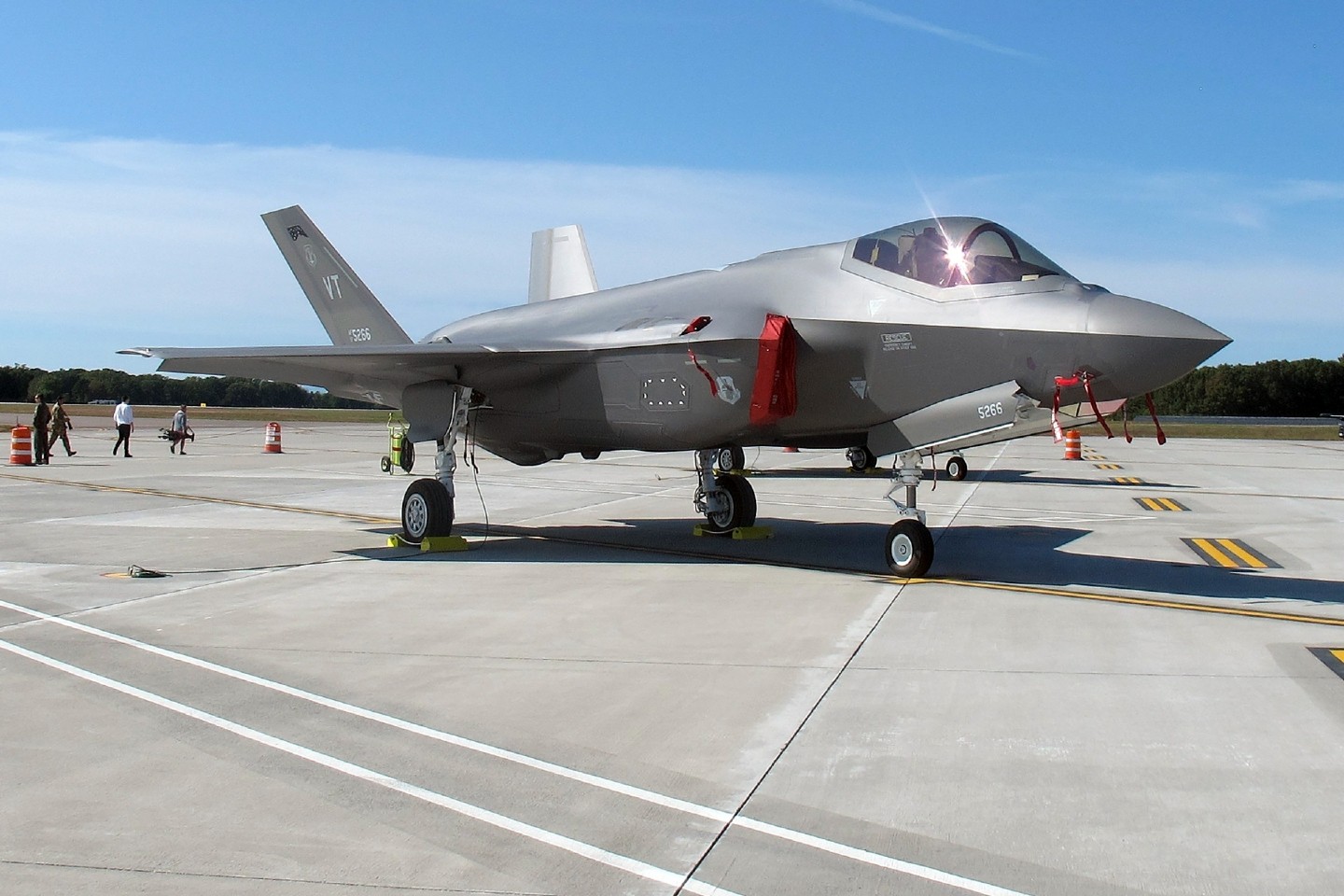
Last week, the top officer of the U.S. Air Force told reporters he was launching a months-long “TacAir” study—short for tactical aviation requirements—into a “force mix” that would possibly involve what he imagined as a “fourth-and-a half/fifth-gen minus” aircraft.
Chief of Staff Gen. Charles Q. Brown Jr. said the budget request for fiscal year 2023 might procure planes with a “clean-sheet design”—that is, the Air Force may not pursue the current replacement plan for the aging fleet, which was to order thousands of the F-35 Joint Strike Fighter.
In other words, the F-35 stealth fighter, the most expensive Defense Department weapon ever, might be phased out in favor of a jet that’s supposed to be lighter weight and less expensive. Brown’s remarks were seen as a tacit recognition that the F-35 had failed.
In September, the Pentagon updated its total planned cost for the F-35 program to $1.727 trillion—an estimate, because the troubled planes have flown only about 2% of their total flight hours over their expected life cycle. According to a new report from nonpartisan watchdog The Project on Government Oversight (POGO), tests of the enormous, 20-year program continue to reveal “significant deficiencies.” Some of the major issues among the F-35’s 871 unresolved deficiencies include false battery warnings, unplanned hard landings, a loss of stealth at supersonic speeds—even, for a plane named the Lightning II, being unsafe to fly near lightning (or in cold weather). Whether it will be a reduction in F-35 orders or a shutdown in production, military officials acknowledge that cuts to the high-profile program are being considered.
F-35 manufacturer Lockheed Martin stands as the largest defense contractor in the world and receives more U.S. public funding than any other corporation. Together, the big five weapons contractors (Lockheed, with Boeing, General Dynamics, Raytheon, and Northrop Grumman) take in more from sales to the U.S. government than the next 30 companies combined. Last month, Lockheed signed a $1.28 billion support contract for the F-35’s, and in 2018 it made over $35 billion in sales to the U.S. government, according to the financial news company 24/7 Wall St, “more than the entire budget of the Internal Revenue Service and Environmental Protection Agency combined.”
A couple of days after the Air Force announcement, Greg Ulmer, executive vice president of Lockheed Martin’s Aeronautics business area, ventured out to defend the value of the F-35, describing it as a sophisticated “system of systems,” with features like the most advanced sensor suite of any fighter in history.
The $428 billion spent to date (out of the $1.7 trillion planned budget) on somewhere over 400 F-35 stealth jets could have been allocated to pressing needs in public investment, like building community broadband or repairing infrastructure. With 70% of Lockheed’s net sales coming from the U.S. government and requiring congressional approval, what options are available to prevent further contracting waste like the fortune sunk in the F-35?
Dan Grazier, a military analyst at POGO and author of the latest F-35 report, told me that in addition to making campaign contributions, Lockheed Martin increases its influence on Capitol Hill by spreading out its contracts. “The economic impact and the appearance of jobs created among their constituents tends to make members of Congress vocal advocates for particular programs,” Grazier said. “You can get a real sense of that by watching the comments and questions asked during hearings when members bring up issues that directly impact programs built in their state or district.”
Many of the members of Congress who continually approved outlays on the F-35 despite mounting design flaws are personally invested in Lockheed Martin. As of January 2020, our analysis found, at least 18 members of Congress held as much as $760,000 worth of stock of Lockheed Martin, including Sen. Roy Blunt (R-Mo.), who owned as much as $100,000 worth. Nearly one-third of the members of the Defense Subcommittee of the Appropriations Committee own stocks in top defense contractors.
Grazier says that the F-35 contracting sprawl stemmed from the design pressures of trying to be all things to all people. “The F-35 became a monster before the first contract was signed. Trying to build a single aircraft that could meet all of the mission needs of three US services and the needs of foreign militaries is a daunting prospect that is nearly impossible and guaranteed to cost a fortune,” Grazier said. On how Congress could look to reform the process that leads to runaway costs, he said, “One contracting issue that could have made a big difference in this case is to make sure the government owns the intellectual property rights from the outset. That way there can be genuine competition when support contracts are negotiated.”
In July, U.S. House progressives introduced an amendment to cut the Pentagon’s budget by 10%, with a companion Senate version calling for the savings to be invested in health care, housing, and emergency pandemic response. All Republicans and the majority of House Democrats voted against the proposal, knocking it down by a vote of 139 to 92 within the Democratic caucus and 324 to 93 overall in the House. We found that the Democrats who voted against the proposal received, on average, 3.4 times the amount of contributions from the defense industry than those who favored the cuts. A July poll by Data for Progress found that voters supported the cuts by a two-to-one margin.
House Armed Services Committee chair Adam Smith (D-Wash.), whose committee has jurisdiction over the Defense Department’s $740.5 billion budget, said during a 2018 primary contest that he had voted against certain weapons programs, but he joined the majority in shooting down the proposed 10% cut to the Pentagon’s funding. Among all House Democrats, Rep. Smith was the top recipient of contributions in the 2020 election cycle from Lockheed’s employees and PAC, according to the Center for Responsive Politics, with $61,200 received, and he brought in more in donations from defense industry PACs than any other sector.
The new chair of the House Defense Appropriations Subcommittee, which approves the annual spending for the F-35 and other programs, is Rep. Betty McCollum of Minnesota. The St. Paul-area Rep. McCollum takes the reins from retired Indiana Rep. Pete Visclosky, who had been the top recipient of defense industry cash among House Democrats. Lockheed’s PAC contributed $20,000 to McCollum’s campaign and leadership committees in the 2020 cycle, an increase from their donations in the previous cycles. Lockheed Martin is among the top career donors to other subcommittee members, including the following: Rep. Dutch Ruppersberger of Maryland (fourth-highest, at $88,000); Republican ranking member Rep. Ken Calvert of California (highest, at $159,050); Republican Rep. Hal Rogers of Kentucky (third-highest, at $104,975); Republican Rep. Robert Aderholt of Alabama (twelfth-highest, at $87,250); and Republican Rep. John Carter of Texas (ninth-highest, at $71,546).
“Because the military industrial congressional complex continually pursues ever more expensive weapon systems, service leaders have to cut back on last year’s prized weapon so they can buy more of the new ones,” Grazier wrote last year on the F-35’s true costs.
The congressional process that kept billions of dollars flowing to the F-35 through delays and cost overruns is kept humming not only by campaign contributions, but also by the prospect of well-compensated positions for former government officials at defense companies. Previously, POGO had noted on the F-35, “The sheer size of the program provides many opportunities for officials involved in the program to travel through the revolving door between government and industry.” A 2018 POGO report, Brass Parachutes, found that 51 of Lockheed’s 62 lobbyists previously served in government positions. Last year, POGO highlighted the example of the former commandant of the Marine Corps, Gen. Joseph Dunford, whose cheerleading support for the F-35’s capabilities despite its combat deficiencies preceded him taking a Lockheed Martin board seat just over four months after his retirement.
For more muckraking reporting on congressional appropriations, join the Sludge newsletter.
